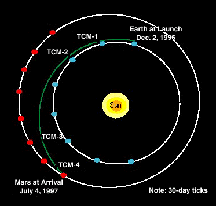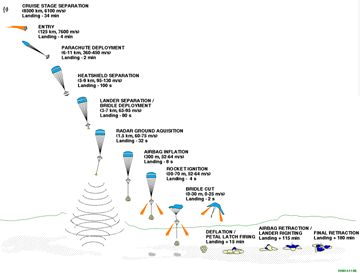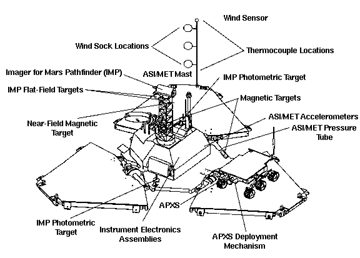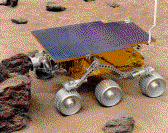
Mars Pathfinder Fact Sheet
Mission Summary

Artist's Concept Of Lander And Microrover On Mars
The Mars Pathfinder Mission is the second launch in the Discovery Program,
a NASA initiative for planetary missions with a maximum three year development
cycle and a cost cap of $150M (FY92) for development. The Mars Pathfinder
is managed for NASA by the Jet
Propulsion Laboratory, California
Institute of Technology, Pasadena, California.
The mission is primarily an engineering demonstration of key technologies
and concepts for eventual use in future missions to Mars employing scientific
landers. Pathfinder also delivers science instruments
to the surface of Mars to investigate the structure of the martian atmosphere,
surface meteorology, surface geology, form, and structure, and the elemental
composition of martian rocks and soil. In addition a free-ranging surface rover is deployed to conduct technology
experiments and to serve as an instrument deployment mechanism.
Mission Description
The flight system is launched on a Delta II-7925
launch vehicle which includes a payload assist module (PAM)-D upper
stage, from the Cape Canaveral Air Station.
The mission launch window is a 29-day period beginning on December 2, 1996.
After launch, the spacecraft requires 6 to 7 months to reach Mars, depending
upon the exact launch date. During this phase, a series of four trajectory
correction maneuvers (TCMs) are performed, in order to fine tune the flight
path. Tracking, telemetry, and command operations with the spacecraft are
conducted using the giant dish antennas of the NASA/JPL Deep
Space Network (DSN). Upon arrival at Mars on July 4, 1997, the spacecraft
will enter the martian atmosphere, and then
deploy the parachute, rocket braking system, and
air bag system for a soft, upright landing.
At this point the primary data-taking phase begins, and continues for 30
martian days or sols (24.6 hours).
During this time, the microrover is
deployed and operated for at least 7 sols. If the lander and rover continue
to perform well at the end of this period, an extended mission may continue
for up to one martian year for the lander, and the microrover for up to
30 sols.
Major Mission Characteristics
- Launch Period
- December 2 - 31, 1996
- Launch Vehicle
- Delta II - 7925
- Trajectory
- 6-7 Months
- Primary Mission
- Land On Mars - July 4, 1997
- Complete Surface Mission
- August 1997
- End Of Project
- September 1998
Interplanetary Trajectory

Entry Descent Landing (EDL)

Spacecraft Characteristics
Spacecraft Parts Indentification

Flight System Characteristics
- Launch Mass
- 890 kg (Includes Propellant)
- Entry Mass
- 570 kg
- Lander Mass
- 360 kg
- Basic Design
- Command And Data Handling
- Integrated Attitude and Information Management System (AIM)
- Computation
- R6000 Computer with VME bus, 22 Millions Of Instructions Per Second
(MIPS), 128 Mbyte mass memory
- Power
- Solar powered cruise stage and lander
- Telemetry And Command
- Surface operations telemetry rate via High
Gain Antenna (HGA), X-Band:
- 6 kb/s to 70-m Deep Space Network
- Surface operations command rate via HGA, X-Band:
- Propulsion
- Monopropellant hydrazine used for cruise
- Eight 4.4-N thrusters
- Total delta-v of 130 m/s
Science Payload Characteristics

- Total Mass
- 16 kg
- Mobile Mass
- 11.5 kg including APXS deployment mechanism
and APXS Instrument
- Lander-Mounted Rover Equipment Mass:
- 4.5 kg including ultra-high frequency (UHF) modem and support structure.
- Autonomous Navigation
- On board, using laser striping for obstacle detection
- Mobility System
- Six-wheel, rocker bogie suspension
- Command And Telemetry
- UHF link with lander
- Payload
- Aft and fore cameras, APXS, APXS deployment mechanism
- Power
- 0.25-M2 Solar panels, peak power 16 W-hours: primary
battery, 50 W-hours
- Thermal Control
- Three radioisotope header units (RHUs)
- Computer Characteristics
- 80C85, 0.1 MIPS; 0.5 Mbyte RAM mass storage; 0.5 kg, 1.5 W
- Surface Ops Time
- 10 A.M. to 2 P.M. each martian day (sol)
Mars Pathfinder Mission Management
- NASA Program Manager
- Donald Ketterer
- NASA Program Scientist
- Joseph Boyce
- JPL Project Manager
- Anthony J. Spear
- JPL Project Scientist
- Dr. Matthew P. Golombek

JET PROPULSION LABORATORY
CALIFORNIA INSTITUTE OF TECHNOLOGY
NATIONAL AERONAUTICS AND SPACE ADMINISTRATION
PASADENA, CALIF. 91109
TELEPHONE (818) 354-5011
This Document Was Last Updated: 19 March 1997